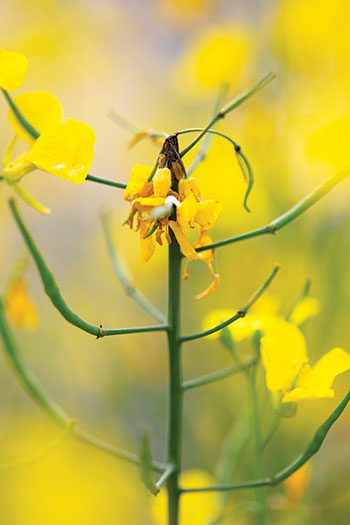It has been at least 10 years since Australian canola growers suffered a severe and damaging outbreak of blackleg infection.
However, this successful defence requires continual vigilance and even experienced growers need to remember that blackleg control relies on year-round integrated disease management (IDM), not just in-season fungicide use.
Specialist canola pathologist Dr Steve Marcroft of Marcroft Grains Pathology says the biggest challenge posed by blackleg is its ability to rapidly overcome varietal resistance.
“Blackleg is caused by the fungus Leptosphaeria maculans, which is highly mutable and can adapt to resistance traits within just a few seasons,” Dr Marcroft says.
“Disease pressure from conducive weather conditions and high inoculum loads both amplify the risk.”
A range of factors have led to high rates of canola planting in recent years. These include record prices for canola, the end of the genetic modification (GM) moratorium in South Australia, and relatively good rainfall.
The increased stubble and moisture mean growers need to be vigilant.
Assess yield benefit of control
Canola growers should be monitoring their blackleg infection rates right through the season, from emergence until harvest.
 Canola flower showing evidence of blackleg infection. Photo: Steve Marcroft
Canola flower showing evidence of blackleg infection. Photo: Steve Marcroft
Dr Marcroft warns disease severity varies widely from year to year. Low severity in past seasons is no guarantee of a low risk this year.
“Disease pressure begins with stubble loads, so as more land is planted to canola there is more stubble and inoculum around,” Dr Marcroft says.
“Highest infection risk is generally from June to August, putting early flowering crops at risk of upper canopy infection (UCI) if they commence flowering before mid-August and late-sown crops at risk of crown canker if they are still in the cotyledon growth stage in June.
“Our current resistance ratings only apply to crown canker infection, making UCI more of a risk for growers.”
Fungicides will control both UCI and crown canker (with different application timings) in all crops. However, the decision to apply a fungicide should always be based on the probability of blackleg-related yield losses occurring.
Growers are encouraged to use the BlacklegCM app to calculate whether applying fungicide is likely to deliver an economic benefit against crown canker. If there is no benefit, spraying might only encourage fungicide resistance in the pathogen population and limit fungicide rotation options if spraying for UCI becomes necessary later in the season.
Dr Marcroft has never seen a yield loss resulting from UCI when flowering occurred after mid-August.
Field-checking cultivar resistance
Even in spring, the most important aspect of blackleg management needs to be done.
At or just before windrowing, growers need to assess the susceptibility of their current cultivar to the blackleg strains in each paddock.
As per the Blackleg Management Guide, this involves pulling out 60 plants at random and cutting the roots off at the crown. Inspect the stem to assess how much of its cross-section is affected by blackleg.
“If it is more than 50 per cent, varietal resistance may be compromised and a new variety, ideally from a different resistance group, should be ordered for the following season,” Dr Marcroft says.
“Keep a record of these inspections each year. If disease levels over the past three seasons appear to be increasing, it is advisable to change cultivars before the problem gets worse.
“Growers should also review their disease management practices to ensure they are optimal.”
Future crop planning
While UCI can now be monitored and controlled through to harvest, growers should already be looking ahead to next season’s canola program.
Dr Marcroft says planning starts with identifying paddocks that provide adequate distance from this year’s stubble.
For crown canker, a 500-metre distance from previous season stubble is the best way to reduce infection rates. UCI is also reduced by this 500m distance, but maintaining the same distance from two-year-old stubble has also been shown to have an impact.
Cultivar choice can be led by the required herbicide tolerance and then yield potential. From the suitable options, growers should then choose a cultivar with the highest possible blackleg resistance rating from their list of suitable options.
Seed from open-pollinated cultivars can be retained and planted, and this may be beneficial, especially while hybrid cultivars are in such high demand. However, some older open-pollinated cultivars have reduced blackleg resistance, so it is important to check the current blackleg ratings each year. Retained cultivars with reduced blackleg resistance should be monitored closely and protected with fungicide applications if blackleg develops.
Prior to sowing, using the BlacklegCM decision support tool will help identify high-risk paddocks so that management strategies can be planned in advance.
“When blackleg is managed well, yield losses are minimal,” Dr Marcroft says.
“However, yield losses can be very significant and large areas can be put at risk if things go wrong.”
More information: Steve Marcroft, Marcroft Grains Pathology,
Useful resources
GroundCover articles:

























































